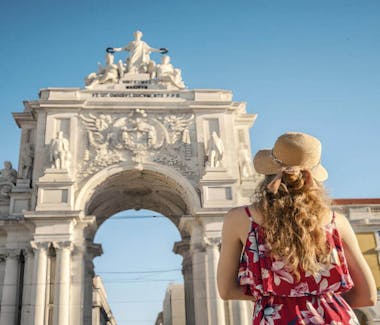Atrações

Rua Augusta 2, 1100-053 Lisboa, Portugal
Arco da Rua Augusta
This triumphal arch in Rua Augusta has always impressed those roaming Lisbon’s busiest pedestrianised street.
But now you can visit the top of this unique structure for a truly singular and impressive view of Baixa and the river. It symbolises the rebirth of a new Lisbon after the tragedy of the earthquake, fire and tsunami in 1755 that razed what stood before.
And it affirms, in Latin, “The Virtues of the Greatest”: the strength, resilience and achievements of the Portuguese people.
At the top stand the sculptures by Célestin Anatole Calmels of Glory crowning Genius and Valour. You can’t help but be inspired by these values as you admire the 360º view of the best Lisbon has to offer. The remaining statues, by Victor Bastos, represent figures of our history. On the left we find the Marquis of Pombal, the following are Vasco da Gama and Viriato and, on the right, Nuno Álvares Pereira.
Discover the history of this arch in the exhibition in the Clock Room for a sense of what it stands for.

Baixa de Lisboa, 1100-052 Lisboa, Portugal
Calçada portuguesa
Portuguese paving, calçada portuguesa, is one of Lisbon’s trademarks.
Playing a huge role in creating the city’s special atmosphere, as it reflects all of the light that falls on it, it is also one of the oldest features of the city.
Made using limestone cubes shaped and placed by hand by skilful craftsmen, the designs can be geometric, figurative or specific depending on the particular location and the tastes of the time.
Enjoy the undulating pattern in Avenida da Liberdade or stand back and observe the symmetry of the design in Chiado.
It’s worth walking down the same street twice, once to look at the buildings and another to discover the impressive designs on the ground.

Monasterio de los Jerónimos de Belém, Lisbon, Portugal
The Jerónimos Monastery
The Jerónimos Monastery is a National Monument and was classified a UNESCO World Heritage Site in 1983.
King Manuel I built a large monastery near the location where the Infante D. Henrique ordered a church to be built in the mid-15th century by invocation of St. Mary of Belém.
To immortalise the memory of the Infante, for his intense devotion to Our Lady and faith in St. Jerome, in 1496 King Manuel I decided to found the Monastery of St. Mary of Belém, near the city of Lisbon, next to the Tagus River.
Donated to the monks of the Order of St. Jerome, today it is commonly known as the Jerónimos Monastery.
A pantheon of the Avis-Beja Dynasty, in the 19th century the church became the sepulchre for heroes and poets: Vasco da Gama and Luís de Camões.
A notable work of architecture, it became part of Portuguese identity and culture.

MAAT - Museum of Art, Architecture and Technology, Avenida Brasília, Lisbon, Portugal
Museum of Art, Architecture and Technology
MAAT – Museum of Art, Architecture and Technology – is the new cultural project for the city of Lisbon. It’s a museum where these three areas intertwine within a space of debate, discovery, critical thinking and international dialogue. It’s an innovative project which establishes a connection between the new building, designed by Amanda Levete Architects’ studio and the Tejo Power Station, one of Portugal’s most prominent examples of industrial architecture from the first half of the 20th century, and one of the most visited museums in the country.

1100-148 Lisboa, Portugal
Praça do Comércio
This is one of the most beautiful squares in all Europe, opening southwards onto the huge Tagus estuary.
Until the era of mass aviation, this was Lisbon´s great reception hall for visitors arriving by sea even better able to enjoy its beauty from their vantage points on slowly docking vessels.
It was at the dock here that the Kings and Heads of State would disembark when visiting Portugal.

R. da Bica de Duarte Belo, 1200-056 Lisboa, Portugal
Elevador da Bica
If you want a unique experience in Lisbon, take the Elevador da Bica.
The most photographed funicular in Lisbon, due to the dramatic contrast between the steep route and the river in the background, this is one of the city’s greatest attractions. It connects Largo do Calhariz to Rua de São Paulo in a heady descent possible on foot but an ascent only suitable for the hardy.
Decorated by artists and witness to the vibrant nightlife in Rua da Bica, the tram seems to share the excitement of the rest of the city during the Festas Populares.
Deemed a national monument since 2002 and in operation for a century, try and photograph the two trams as they cross, with the colourful houses and flowery verandas the perfect backdrop.

R. de Santa Justa 1150-060, Lisboa, Portugal
Elevador de Santa Justa
The Elevador de Santa Justa is one of the city’s most famous sights.
Designed by Mesnier du Ponsard, it was originally called the Ascensor Ouro-Carmo.
It connects Rua do Ouro to Largo do Carmo via a neogothic-style structure completely unlike any of the other elevadores in the city.
The lifts themselves, made of wood elegantly decorated with brass, evoke a journey in time as they ascend and descend towards the most exclusive areas of the city.
At the top of the tower is one of the best viewing points in the city, providing a splendid panorama of Baixa, Castelo, the Tagus and also the impressive ruins of the church of the Convento do Carmo.
